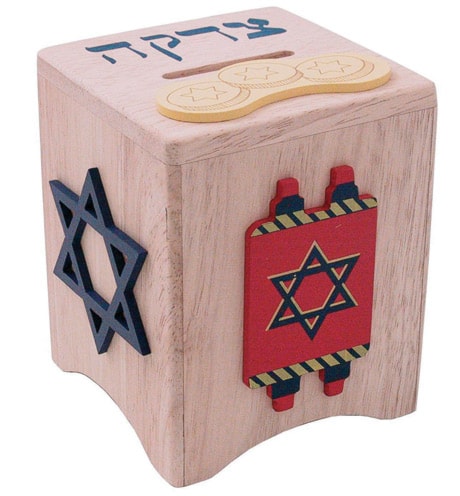Invited to a Hanukkah party?
Consider a charity box as a worthy gift that goes straight to the core of Jewish life.
Giving charity, called tzedakah in Hebrew, is a righteous obligation popularized in less ancient times by the Jewish National Fund’s “blue box” drive in support of Israel.
The organization has been doling out its charity boxes for 109 years, but more ornate containers are out there as sweet, meaningful gifts that would be especially nice for families trying to drive home the importance of giving to children who may not be exposed to the practice of dropping a few coins in a box at synagogue or religious school.
Gifting a tzedakah box in fun or fancy form is more closely associated with weddings, awards and bar mitzvahs than the eight-day festival of lighting candles, spinning dreidels and eating fried foods. That doesn’t mean a charity box wouldn’t make a positive reminder come Hanukkah time, said purveyors and creators of Jewish gifts and ritual items.
“Tzedakah boxes are absolutely a good Hanukkah gift,” said Rabbi Abigail Treu, director of donor relations and development for the Jewish Theological Seminary, a worldwide force in Conservative Judaism.
“It’s another way of thinking about what we have and can help us refocus.”
The Torah promises that by giving tzedakah, “a person’s mind and heart become refined one thousand times.”
Beautifying the performance of the fundamental command through a keepsake tzedakah box can help revive the practice of charity collection in Jewish homes, said Gary Rosenthal, an artist who has been creating pieces of Judaica since the 1970s.
Menorahs, dreidels, cups for Sabbath wine and seder plates for Passover have been popular gifts for decades, he said. Tzedakah boxes for home use are a relatively new addition.
“Twenty years ago I tried to make a tzedakah box and nobody would buy it,” said Rosenthal in Kensington, Md.
“Everybody did it at synagogue but it wasn’t something for the home. More Orthodox and traditional Jews had them, but there was this lost generation after World War II when tzedakah boxes just fell off the radar.”
Rosenthal often works in copper, brass and steel adorned with glass to create ritual items and Jewish gifts.
He expects to sell nearly 6,000 tzedakah boxes worldwide by year’s end, including a limited-edition streetcar with a portion of proceeds going to the Jewish community in New Orleans.
He also has a line decorated with pink glass mosaics designed by people touched by breast cancer to support their cause. “I like to combine art with doing good, when the purchase is actually an act of tzedakah,” Rosenthal said.
More contemporary designers like Rosenthal have delved into Jewish life in recent decades, said Stacey Zaleski, director of merchandising for The Jewish Museum in New York City.
Designs include baseballs for children and globes to symbolize the importance of giving back to the world. They come in bright floral patterns on wood from India.
A top seller by New Mexico artist Alice Warder Seely, called “Joy,” is black wood and pewter and evokes the history and landscapes of the Southwest.
“The idea is to be appealing, so it’s kind of fun to collect charity, something you enjoy doing,” Zaleski said.
Annie Matza runs the small gift shop at Congregation Ner Tamid in Henderson, Nev., outside Las Vegas.
The Reform congregation’s 720 families have plenty of menorahs and dreidels. More popular as Hanukkah gifts are sets of braided candles, wine cups and boxes of fragrant spices to mark the end of the Sabbath, and Mezuzah parchments with Torah portions handwritten by special scribes in cases that hang on doorposts.
She sees tzedakah boxes coming into their own in glass, wood, metal and plastic. “No matter what your taste there’s a tzedakah box for everyone,” she said.
Risa Borsykowsky, who sells Jewish gifts online, said stepping outside the usual traditions of Hanukkah to emphasize tzedakah through a gifted box couldn’t come at a better time. “It helps people who think Hanukkah is the Jewish Christmas realize that it really isn’t,” she said.
“It needs to transcend from Hebrew school to the home and be encouraged by the parents. If parents don’t encourage tzedakah then it’s just a pretty box.”
